Report on Management Structure, Business Functions, and HR
VerifiedAdded on 2022/12/09
|12
|2572
|287
Report
AI Summary
This report provides an in-depth analysis of management structures, exploring their advantages and disadvantages, and their impact on business functions. It delves into the significance of marketing functions and their relationship to overall business success, highlighting the key roles and responsibilities within this domain. The report also examines various management functions, including planning, organizing, staffing, directing, and controlling, emphasizing their crucial roles in achieving organizational objectives. Furthermore, it explores talent management, specifically focusing on the role of Human Resources in recruitment, performance management, career development, and leadership development. The report also analyzes organizational culture and its impact on business performance. The report concludes by summarizing the interconnectedness of these elements and their importance for long-term organizational success.
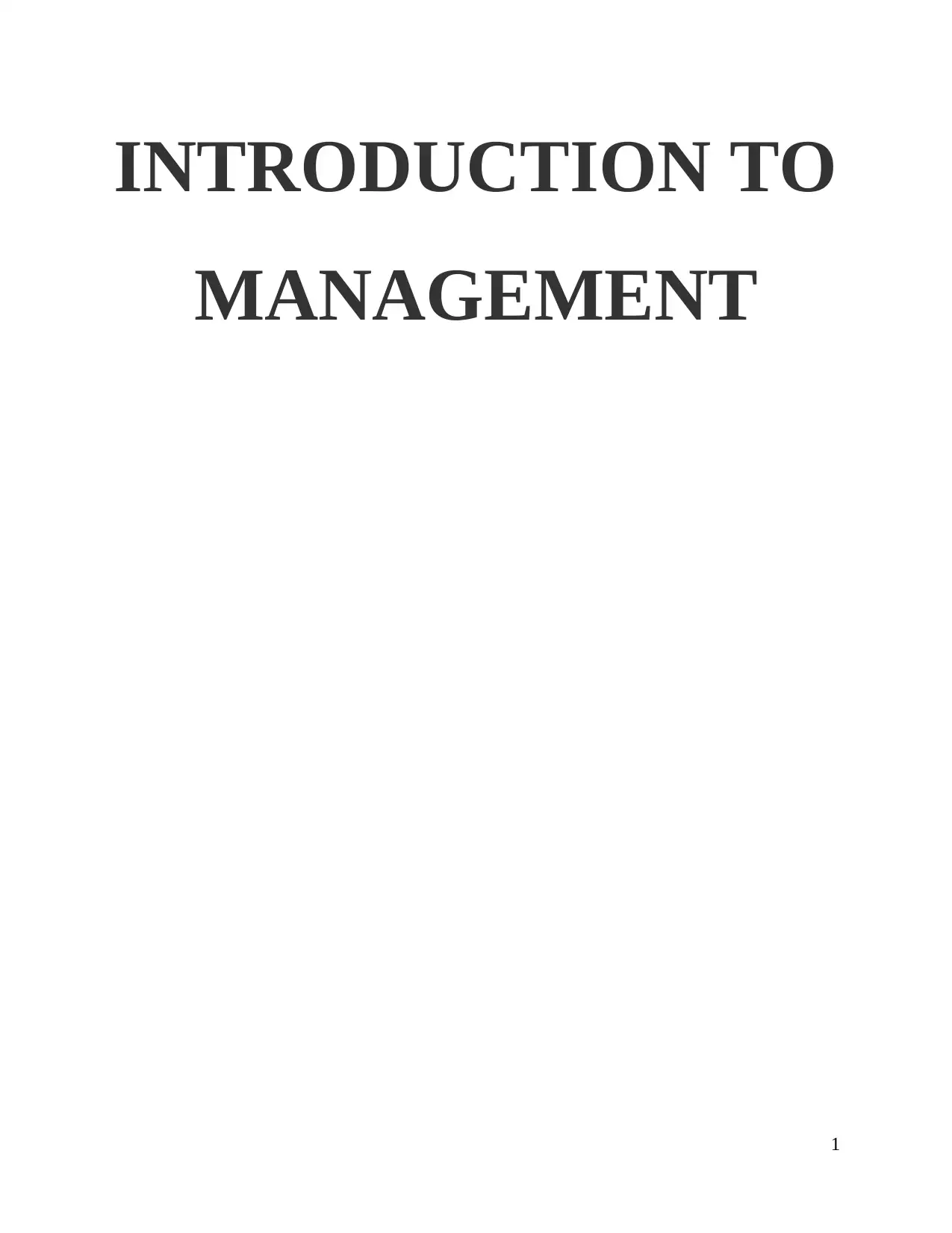
INTRODUCTION TO
MANAGEMENT
1
MANAGEMENT
1
Paraphrase This Document
Need a fresh take? Get an instant paraphrase of this document with our AI Paraphraser
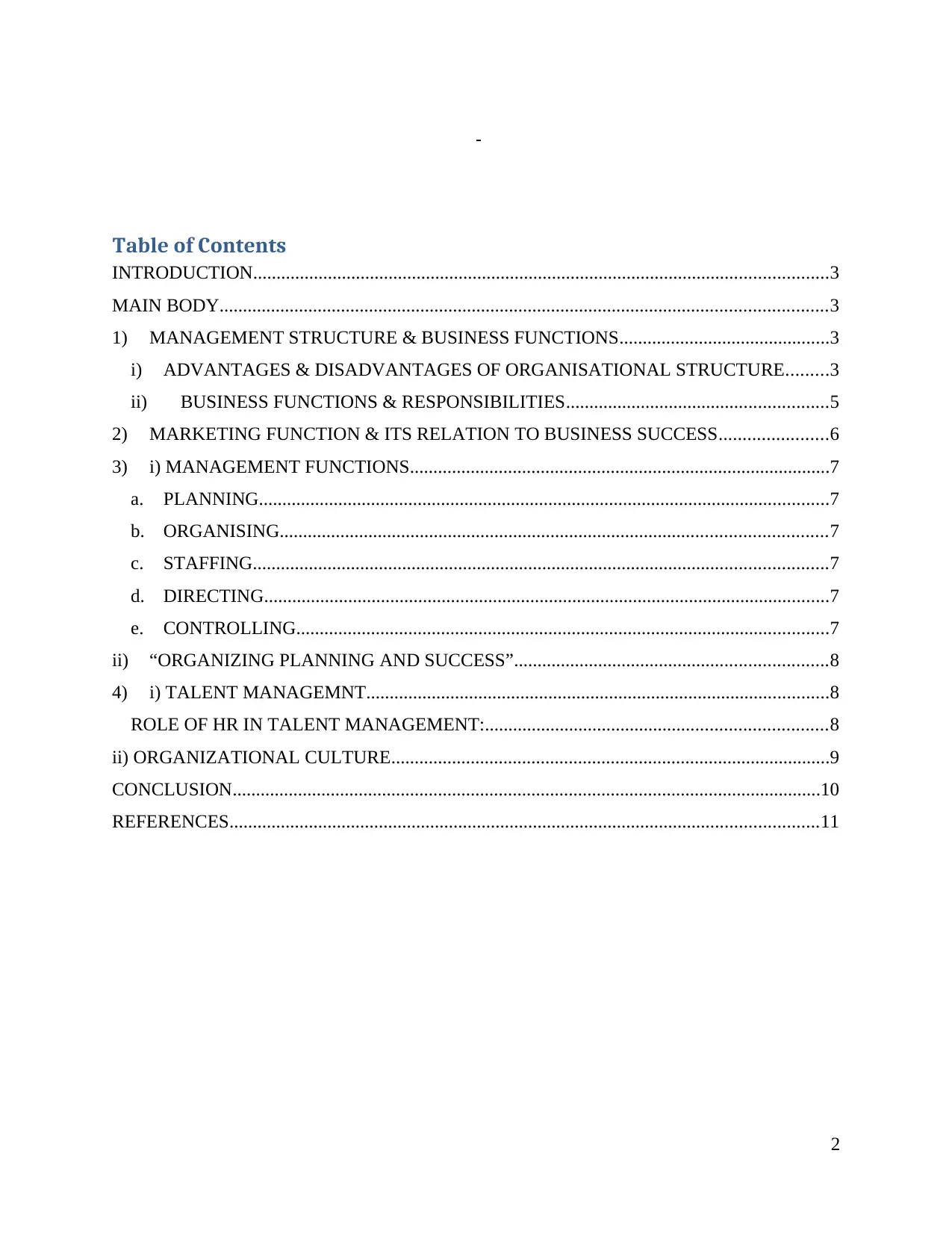
Table of Contents
INTRODUCTION...........................................................................................................................3
MAIN BODY..................................................................................................................................3
1) MANAGEMENT STRUCTURE & BUSINESS FUNCTIONS.............................................3
i) ADVANTAGES & DISADVANTAGES OF ORGANISATIONAL STRUCTURE.........3
ii) BUSINESS FUNCTIONS & RESPONSIBILITIES........................................................5
2) MARKETING FUNCTION & ITS RELATION TO BUSINESS SUCCESS.......................6
3) i) MANAGEMENT FUNCTIONS..........................................................................................7
a. PLANNING..........................................................................................................................7
b. ORGANISING.....................................................................................................................7
c. STAFFING...........................................................................................................................7
d. DIRECTING.........................................................................................................................7
e. CONTROLLING..................................................................................................................7
ii) “ORGANIZING PLANNING AND SUCCESS”...................................................................8
4) i) TALENT MANAGEMNT...................................................................................................8
ROLE OF HR IN TALENT MANAGEMENT:.........................................................................8
ii) ORGANIZATIONAL CULTURE..............................................................................................9
CONCLUSION..............................................................................................................................10
REFERENCES..............................................................................................................................11
2
INTRODUCTION...........................................................................................................................3
MAIN BODY..................................................................................................................................3
1) MANAGEMENT STRUCTURE & BUSINESS FUNCTIONS.............................................3
i) ADVANTAGES & DISADVANTAGES OF ORGANISATIONAL STRUCTURE.........3
ii) BUSINESS FUNCTIONS & RESPONSIBILITIES........................................................5
2) MARKETING FUNCTION & ITS RELATION TO BUSINESS SUCCESS.......................6
3) i) MANAGEMENT FUNCTIONS..........................................................................................7
a. PLANNING..........................................................................................................................7
b. ORGANISING.....................................................................................................................7
c. STAFFING...........................................................................................................................7
d. DIRECTING.........................................................................................................................7
e. CONTROLLING..................................................................................................................7
ii) “ORGANIZING PLANNING AND SUCCESS”...................................................................8
4) i) TALENT MANAGEMNT...................................................................................................8
ROLE OF HR IN TALENT MANAGEMENT:.........................................................................8
ii) ORGANIZATIONAL CULTURE..............................................................................................9
CONCLUSION..............................................................................................................................10
REFERENCES..............................................................................................................................11
2
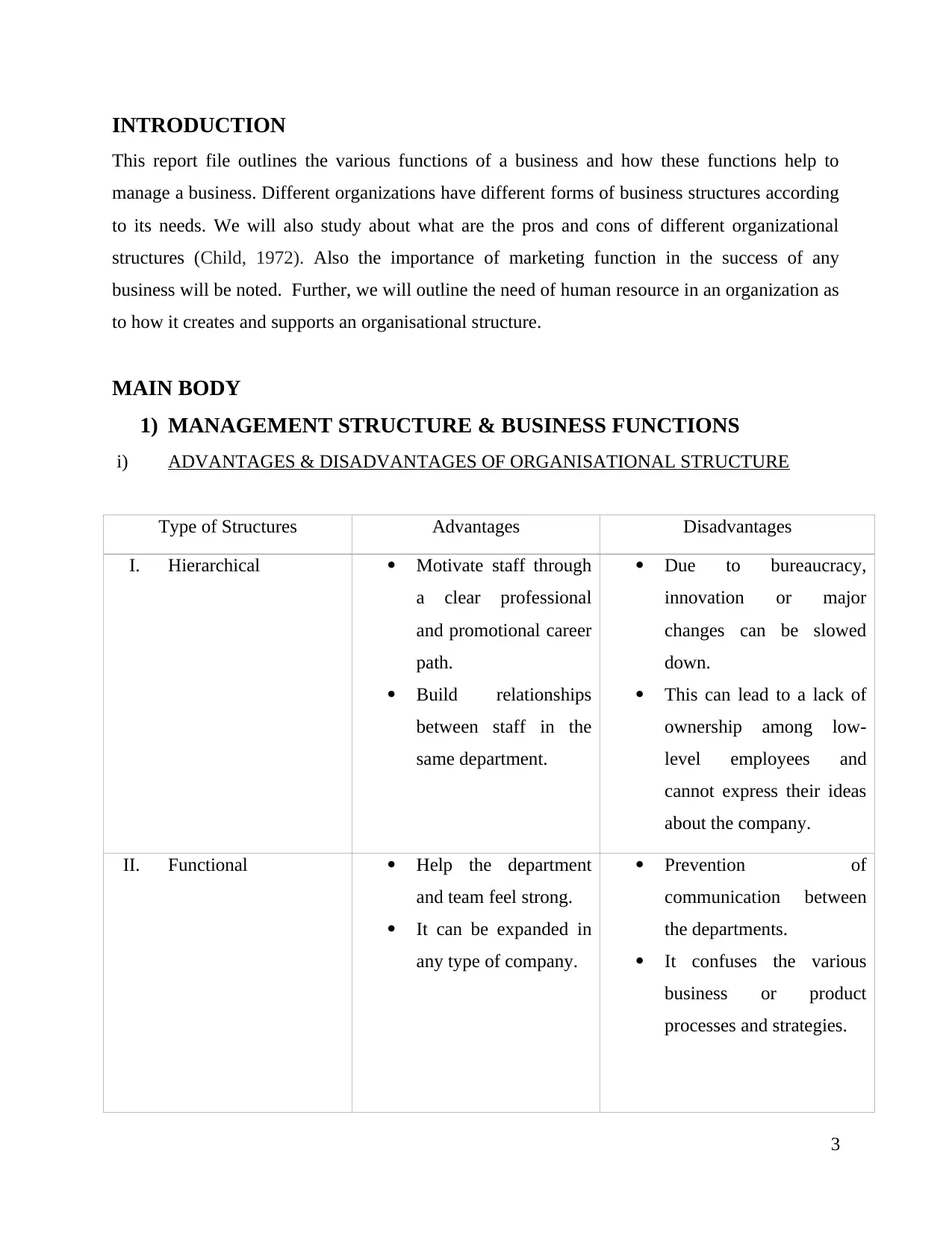
INTRODUCTION
This report file outlines the various functions of a business and how these functions help to
manage a business. Different organizations have different forms of business structures according
to its needs. We will also study about what are the pros and cons of different organizational
structures (Child, 1972). Also the importance of marketing function in the success of any
business will be noted. Further, we will outline the need of human resource in an organization as
to how it creates and supports an organisational structure.
MAIN BODY
1) MANAGEMENT STRUCTURE & BUSINESS FUNCTIONS
i) ADVANTAGES & DISADVANTAGES OF ORGANISATIONAL STRUCTURE
Type of Structures Advantages Disadvantages
I. Hierarchical Motivate staff through
a clear professional
and promotional career
path.
Build relationships
between staff in the
same department.
Due to bureaucracy,
innovation or major
changes can be slowed
down.
This can lead to a lack of
ownership among low-
level employees and
cannot express their ideas
about the company.
II. Functional Help the department
and team feel strong.
It can be expanded in
any type of company.
Prevention of
communication between
the departments.
It confuses the various
business or product
processes and strategies.
3
This report file outlines the various functions of a business and how these functions help to
manage a business. Different organizations have different forms of business structures according
to its needs. We will also study about what are the pros and cons of different organizational
structures (Child, 1972). Also the importance of marketing function in the success of any
business will be noted. Further, we will outline the need of human resource in an organization as
to how it creates and supports an organisational structure.
MAIN BODY
1) MANAGEMENT STRUCTURE & BUSINESS FUNCTIONS
i) ADVANTAGES & DISADVANTAGES OF ORGANISATIONAL STRUCTURE
Type of Structures Advantages Disadvantages
I. Hierarchical Motivate staff through
a clear professional
and promotional career
path.
Build relationships
between staff in the
same department.
Due to bureaucracy,
innovation or major
changes can be slowed
down.
This can lead to a lack of
ownership among low-
level employees and
cannot express their ideas
about the company.
II. Functional Help the department
and team feel strong.
It can be expanded in
any type of company.
Prevention of
communication between
the departments.
It confuses the various
business or product
processes and strategies.
3
⊘ This is a preview!⊘
Do you want full access?
Subscribe today to unlock all pages.

Trusted by 1+ million students worldwide
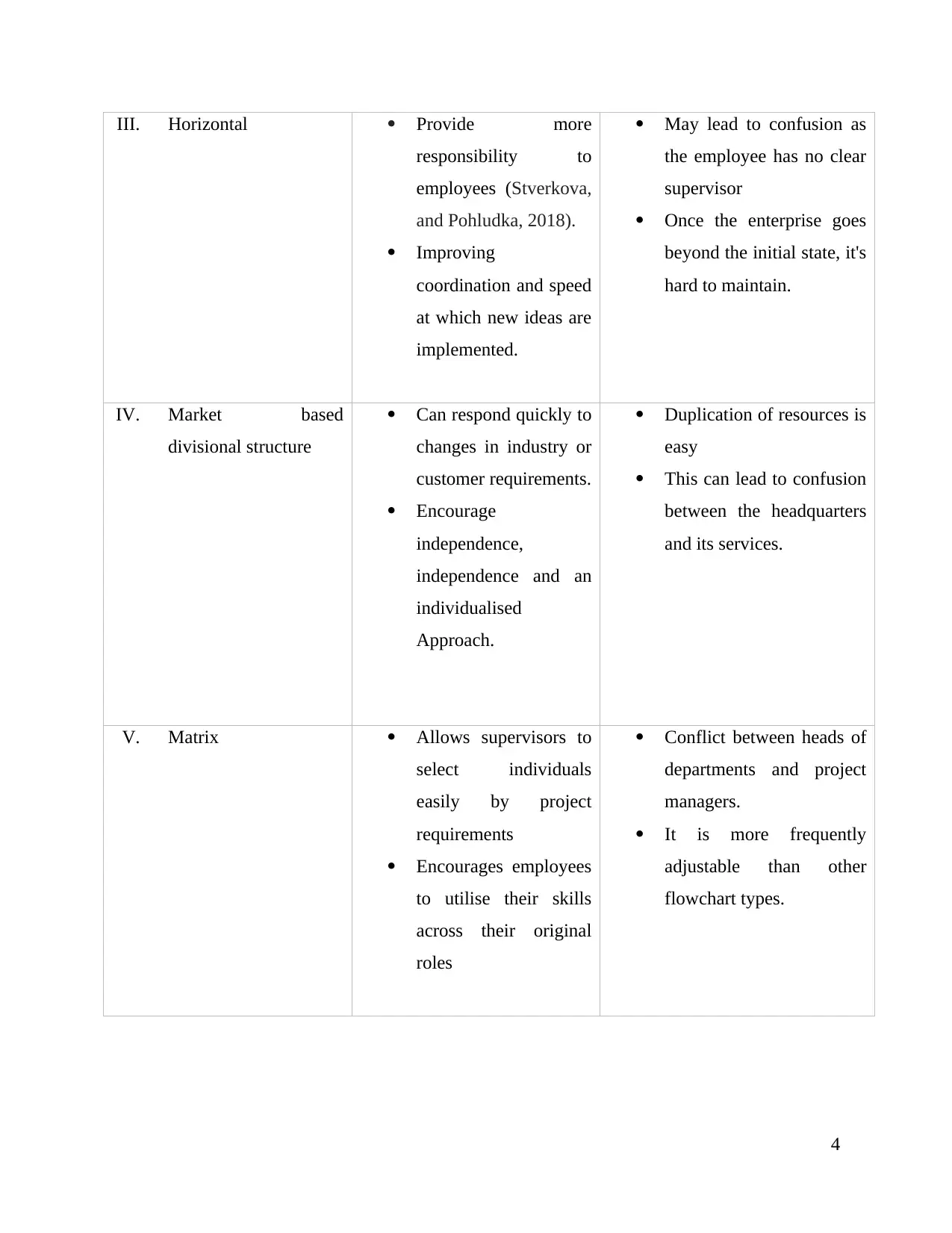
III. Horizontal Provide more
responsibility to
employees (Stverkova,
and Pohludka, 2018).
Improving
coordination and speed
at which new ideas are
implemented.
May lead to confusion as
the employee has no clear
supervisor
Once the enterprise goes
beyond the initial state, it's
hard to maintain.
IV. Market based
divisional structure
Can respond quickly to
changes in industry or
customer requirements.
Encourage
independence,
independence and an
individualised
Approach.
Duplication of resources is
easy
This can lead to confusion
between the headquarters
and its services.
V. Matrix Allows supervisors to
select individuals
easily by project
requirements
Encourages employees
to utilise their skills
across their original
roles
Conflict between heads of
departments and project
managers.
It is more frequently
adjustable than other
flowchart types.
4
responsibility to
employees (Stverkova,
and Pohludka, 2018).
Improving
coordination and speed
at which new ideas are
implemented.
May lead to confusion as
the employee has no clear
supervisor
Once the enterprise goes
beyond the initial state, it's
hard to maintain.
IV. Market based
divisional structure
Can respond quickly to
changes in industry or
customer requirements.
Encourage
independence,
independence and an
individualised
Approach.
Duplication of resources is
easy
This can lead to confusion
between the headquarters
and its services.
V. Matrix Allows supervisors to
select individuals
easily by project
requirements
Encourages employees
to utilise their skills
across their original
roles
Conflict between heads of
departments and project
managers.
It is more frequently
adjustable than other
flowchart types.
4
Paraphrase This Document
Need a fresh take? Get an instant paraphrase of this document with our AI Paraphraser
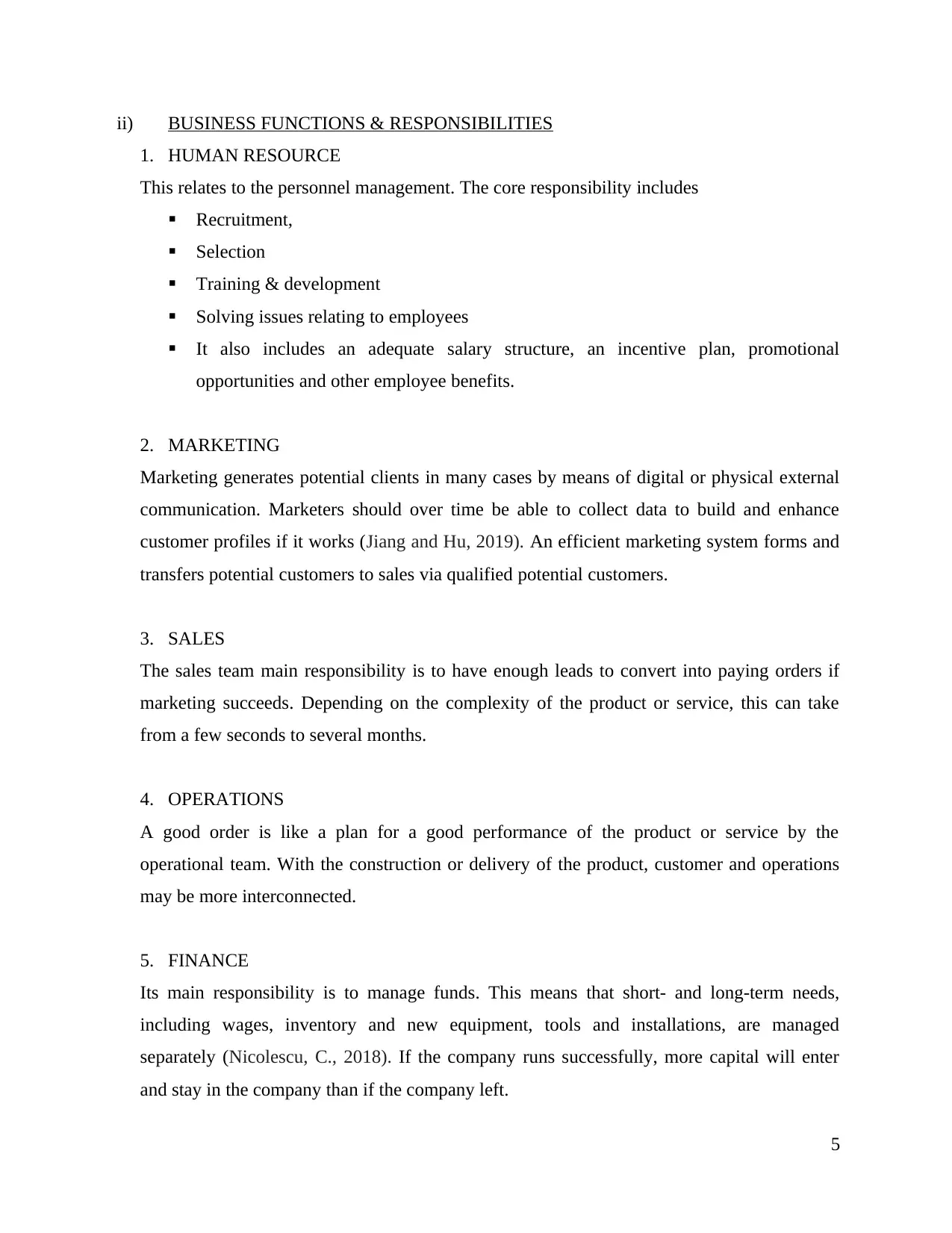
ii) BUSINESS FUNCTIONS & RESPONSIBILITIES
1. HUMAN RESOURCE
This relates to the personnel management. The core responsibility includes
Recruitment,
Selection
Training & development
Solving issues relating to employees
It also includes an adequate salary structure, an incentive plan, promotional
opportunities and other employee benefits.
2. MARKETING
Marketing generates potential clients in many cases by means of digital or physical external
communication. Marketers should over time be able to collect data to build and enhance
customer profiles if it works (Jiang and Hu, 2019). An efficient marketing system forms and
transfers potential customers to sales via qualified potential customers.
3. SALES
The sales team main responsibility is to have enough leads to convert into paying orders if
marketing succeeds. Depending on the complexity of the product or service, this can take
from a few seconds to several months.
4. OPERATIONS
A good order is like a plan for a good performance of the product or service by the
operational team. With the construction or delivery of the product, customer and operations
may be more interconnected.
5. FINANCE
Its main responsibility is to manage funds. This means that short- and long-term needs,
including wages, inventory and new equipment, tools and installations, are managed
separately (Nicolescu, C., 2018). If the company runs successfully, more capital will enter
and stay in the company than if the company left.
5
1. HUMAN RESOURCE
This relates to the personnel management. The core responsibility includes
Recruitment,
Selection
Training & development
Solving issues relating to employees
It also includes an adequate salary structure, an incentive plan, promotional
opportunities and other employee benefits.
2. MARKETING
Marketing generates potential clients in many cases by means of digital or physical external
communication. Marketers should over time be able to collect data to build and enhance
customer profiles if it works (Jiang and Hu, 2019). An efficient marketing system forms and
transfers potential customers to sales via qualified potential customers.
3. SALES
The sales team main responsibility is to have enough leads to convert into paying orders if
marketing succeeds. Depending on the complexity of the product or service, this can take
from a few seconds to several months.
4. OPERATIONS
A good order is like a plan for a good performance of the product or service by the
operational team. With the construction or delivery of the product, customer and operations
may be more interconnected.
5. FINANCE
Its main responsibility is to manage funds. This means that short- and long-term needs,
including wages, inventory and new equipment, tools and installations, are managed
separately (Nicolescu, C., 2018). If the company runs successfully, more capital will enter
and stay in the company than if the company left.
5
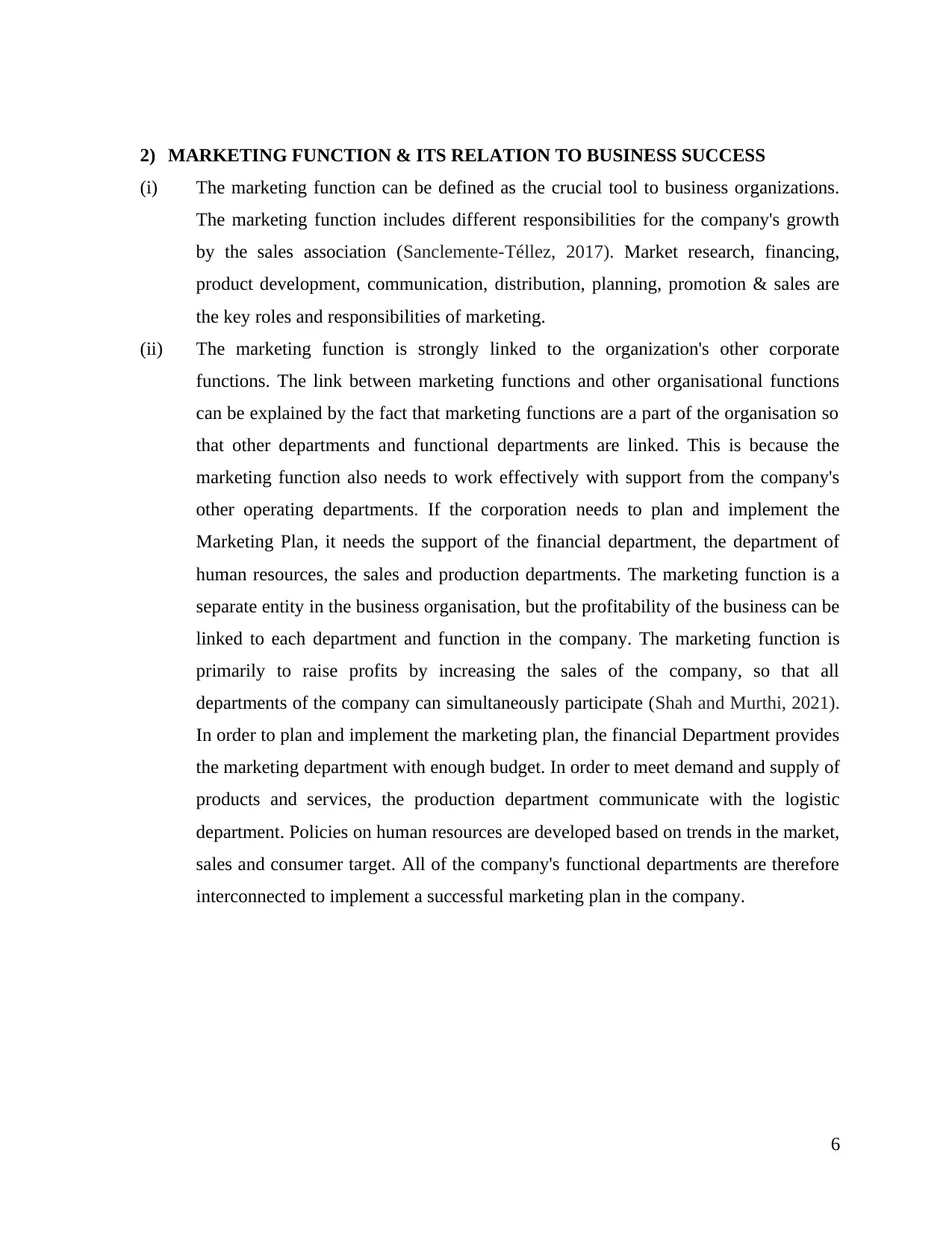
2) MARKETING FUNCTION & ITS RELATION TO BUSINESS SUCCESS
(i) The marketing function can be defined as the crucial tool to business organizations.
The marketing function includes different responsibilities for the company's growth
by the sales association (Sanclemente-Téllez, 2017). Market research, financing,
product development, communication, distribution, planning, promotion & sales are
the key roles and responsibilities of marketing.
(ii) The marketing function is strongly linked to the organization's other corporate
functions. The link between marketing functions and other organisational functions
can be explained by the fact that marketing functions are a part of the organisation so
that other departments and functional departments are linked. This is because the
marketing function also needs to work effectively with support from the company's
other operating departments. If the corporation needs to plan and implement the
Marketing Plan, it needs the support of the financial department, the department of
human resources, the sales and production departments. The marketing function is a
separate entity in the business organisation, but the profitability of the business can be
linked to each department and function in the company. The marketing function is
primarily to raise profits by increasing the sales of the company, so that all
departments of the company can simultaneously participate (Shah and Murthi, 2021).
In order to plan and implement the marketing plan, the financial Department provides
the marketing department with enough budget. In order to meet demand and supply of
products and services, the production department communicate with the logistic
department. Policies on human resources are developed based on trends in the market,
sales and consumer target. All of the company's functional departments are therefore
interconnected to implement a successful marketing plan in the company.
6
(i) The marketing function can be defined as the crucial tool to business organizations.
The marketing function includes different responsibilities for the company's growth
by the sales association (Sanclemente-Téllez, 2017). Market research, financing,
product development, communication, distribution, planning, promotion & sales are
the key roles and responsibilities of marketing.
(ii) The marketing function is strongly linked to the organization's other corporate
functions. The link between marketing functions and other organisational functions
can be explained by the fact that marketing functions are a part of the organisation so
that other departments and functional departments are linked. This is because the
marketing function also needs to work effectively with support from the company's
other operating departments. If the corporation needs to plan and implement the
Marketing Plan, it needs the support of the financial department, the department of
human resources, the sales and production departments. The marketing function is a
separate entity in the business organisation, but the profitability of the business can be
linked to each department and function in the company. The marketing function is
primarily to raise profits by increasing the sales of the company, so that all
departments of the company can simultaneously participate (Shah and Murthi, 2021).
In order to plan and implement the marketing plan, the financial Department provides
the marketing department with enough budget. In order to meet demand and supply of
products and services, the production department communicate with the logistic
department. Policies on human resources are developed based on trends in the market,
sales and consumer target. All of the company's functional departments are therefore
interconnected to implement a successful marketing plan in the company.
6
⊘ This is a preview!⊘
Do you want full access?
Subscribe today to unlock all pages.

Trusted by 1+ million students worldwide
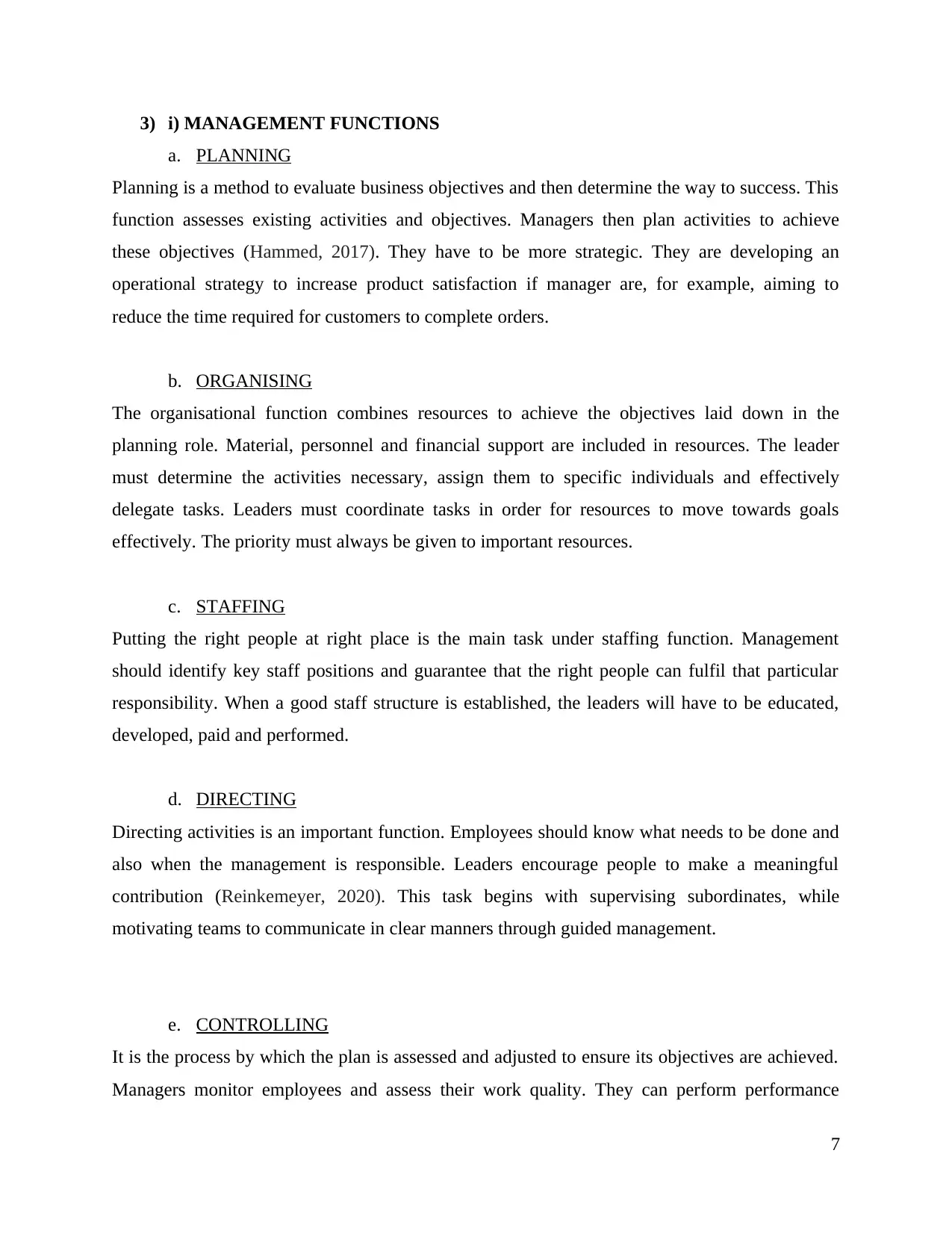
3) i) MANAGEMENT FUNCTIONS
a. PLANNING
Planning is a method to evaluate business objectives and then determine the way to success. This
function assesses existing activities and objectives. Managers then plan activities to achieve
these objectives (Hammed, 2017). They have to be more strategic. They are developing an
operational strategy to increase product satisfaction if manager are, for example, aiming to
reduce the time required for customers to complete orders.
b. ORGANISING
The organisational function combines resources to achieve the objectives laid down in the
planning role. Material, personnel and financial support are included in resources. The leader
must determine the activities necessary, assign them to specific individuals and effectively
delegate tasks. Leaders must coordinate tasks in order for resources to move towards goals
effectively. The priority must always be given to important resources.
c. STAFFING
Putting the right people at right place is the main task under staffing function. Management
should identify key staff positions and guarantee that the right people can fulfil that particular
responsibility. When a good staff structure is established, the leaders will have to be educated,
developed, paid and performed.
d. DIRECTING
Directing activities is an important function. Employees should know what needs to be done and
also when the management is responsible. Leaders encourage people to make a meaningful
contribution (Reinkemeyer, 2020). This task begins with supervising subordinates, while
motivating teams to communicate in clear manners through guided management.
e. CONTROLLING
It is the process by which the plan is assessed and adjusted to ensure its objectives are achieved.
Managers monitor employees and assess their work quality. They can perform performance
7
a. PLANNING
Planning is a method to evaluate business objectives and then determine the way to success. This
function assesses existing activities and objectives. Managers then plan activities to achieve
these objectives (Hammed, 2017). They have to be more strategic. They are developing an
operational strategy to increase product satisfaction if manager are, for example, aiming to
reduce the time required for customers to complete orders.
b. ORGANISING
The organisational function combines resources to achieve the objectives laid down in the
planning role. Material, personnel and financial support are included in resources. The leader
must determine the activities necessary, assign them to specific individuals and effectively
delegate tasks. Leaders must coordinate tasks in order for resources to move towards goals
effectively. The priority must always be given to important resources.
c. STAFFING
Putting the right people at right place is the main task under staffing function. Management
should identify key staff positions and guarantee that the right people can fulfil that particular
responsibility. When a good staff structure is established, the leaders will have to be educated,
developed, paid and performed.
d. DIRECTING
Directing activities is an important function. Employees should know what needs to be done and
also when the management is responsible. Leaders encourage people to make a meaningful
contribution (Reinkemeyer, 2020). This task begins with supervising subordinates, while
motivating teams to communicate in clear manners through guided management.
e. CONTROLLING
It is the process by which the plan is assessed and adjusted to ensure its objectives are achieved.
Managers monitor employees and assess their work quality. They can perform performance
7
Paraphrase This Document
Need a fresh take? Get an instant paraphrase of this document with our AI Paraphraser
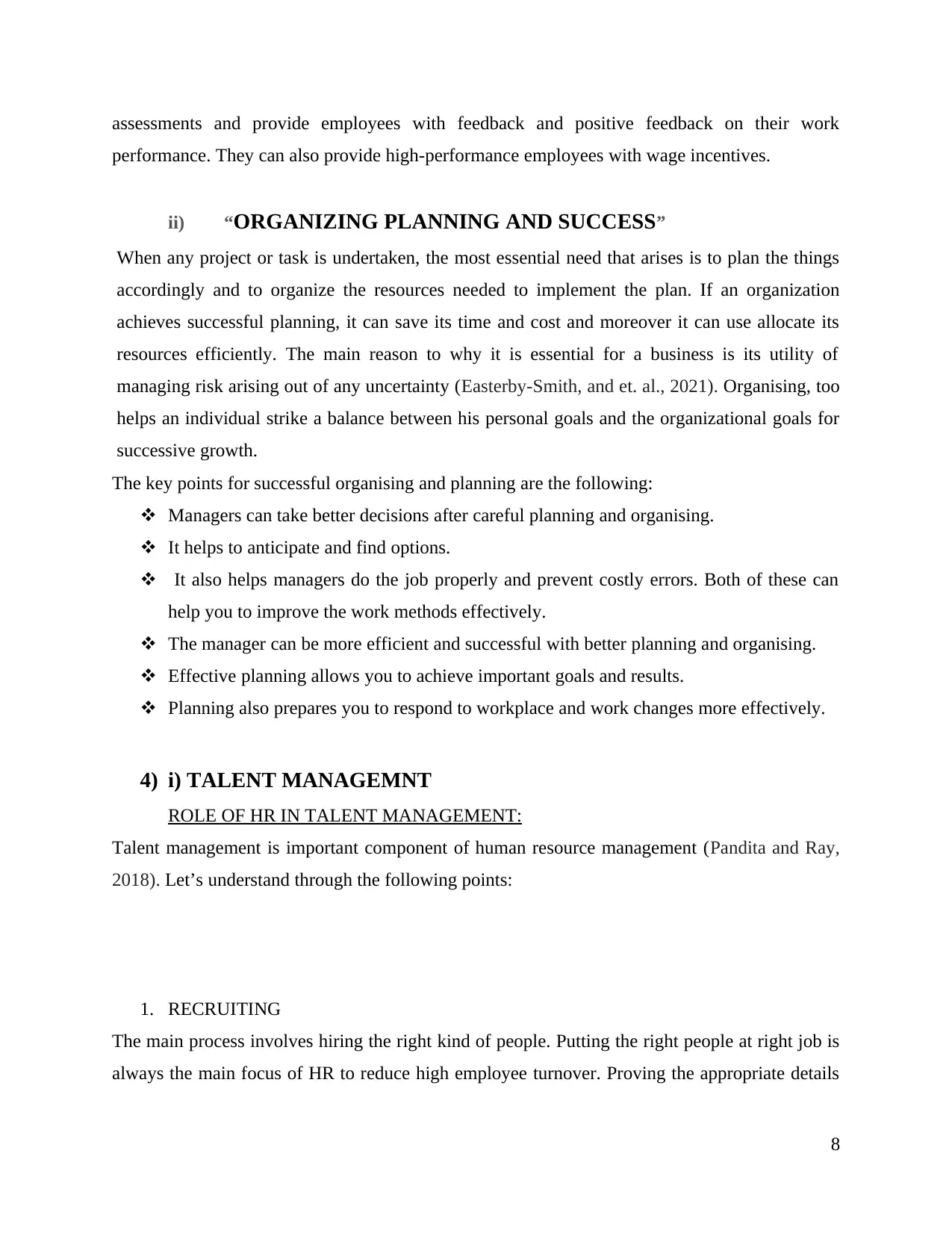
assessments and provide employees with feedback and positive feedback on their work
performance. They can also provide high-performance employees with wage incentives.
ii) “ORGANIZING PLANNING AND SUCCESS”
When any project or task is undertaken, the most essential need that arises is to plan the things
accordingly and to organize the resources needed to implement the plan. If an organization
achieves successful planning, it can save its time and cost and moreover it can use allocate its
resources efficiently. The main reason to why it is essential for a business is its utility of
managing risk arising out of any uncertainty (Easterby-Smith, and et. al., 2021). Organising, too
helps an individual strike a balance between his personal goals and the organizational goals for
successive growth.
The key points for successful organising and planning are the following:
Managers can take better decisions after careful planning and organising.
It helps to anticipate and find options.
It also helps managers do the job properly and prevent costly errors. Both of these can
help you to improve the work methods effectively.
The manager can be more efficient and successful with better planning and organising.
Effective planning allows you to achieve important goals and results.
Planning also prepares you to respond to workplace and work changes more effectively.
4) i) TALENT MANAGEMNT
ROLE OF HR IN TALENT MANAGEMENT:
Talent management is important component of human resource management (Pandita and Ray,
2018). Let’s understand through the following points:
1. RECRUITING
The main process involves hiring the right kind of people. Putting the right people at right job is
always the main focus of HR to reduce high employee turnover. Proving the appropriate details
8
performance. They can also provide high-performance employees with wage incentives.
ii) “ORGANIZING PLANNING AND SUCCESS”
When any project or task is undertaken, the most essential need that arises is to plan the things
accordingly and to organize the resources needed to implement the plan. If an organization
achieves successful planning, it can save its time and cost and moreover it can use allocate its
resources efficiently. The main reason to why it is essential for a business is its utility of
managing risk arising out of any uncertainty (Easterby-Smith, and et. al., 2021). Organising, too
helps an individual strike a balance between his personal goals and the organizational goals for
successive growth.
The key points for successful organising and planning are the following:
Managers can take better decisions after careful planning and organising.
It helps to anticipate and find options.
It also helps managers do the job properly and prevent costly errors. Both of these can
help you to improve the work methods effectively.
The manager can be more efficient and successful with better planning and organising.
Effective planning allows you to achieve important goals and results.
Planning also prepares you to respond to workplace and work changes more effectively.
4) i) TALENT MANAGEMNT
ROLE OF HR IN TALENT MANAGEMENT:
Talent management is important component of human resource management (Pandita and Ray,
2018). Let’s understand through the following points:
1. RECRUITING
The main process involves hiring the right kind of people. Putting the right people at right job is
always the main focus of HR to reduce high employee turnover. Proving the appropriate details
8
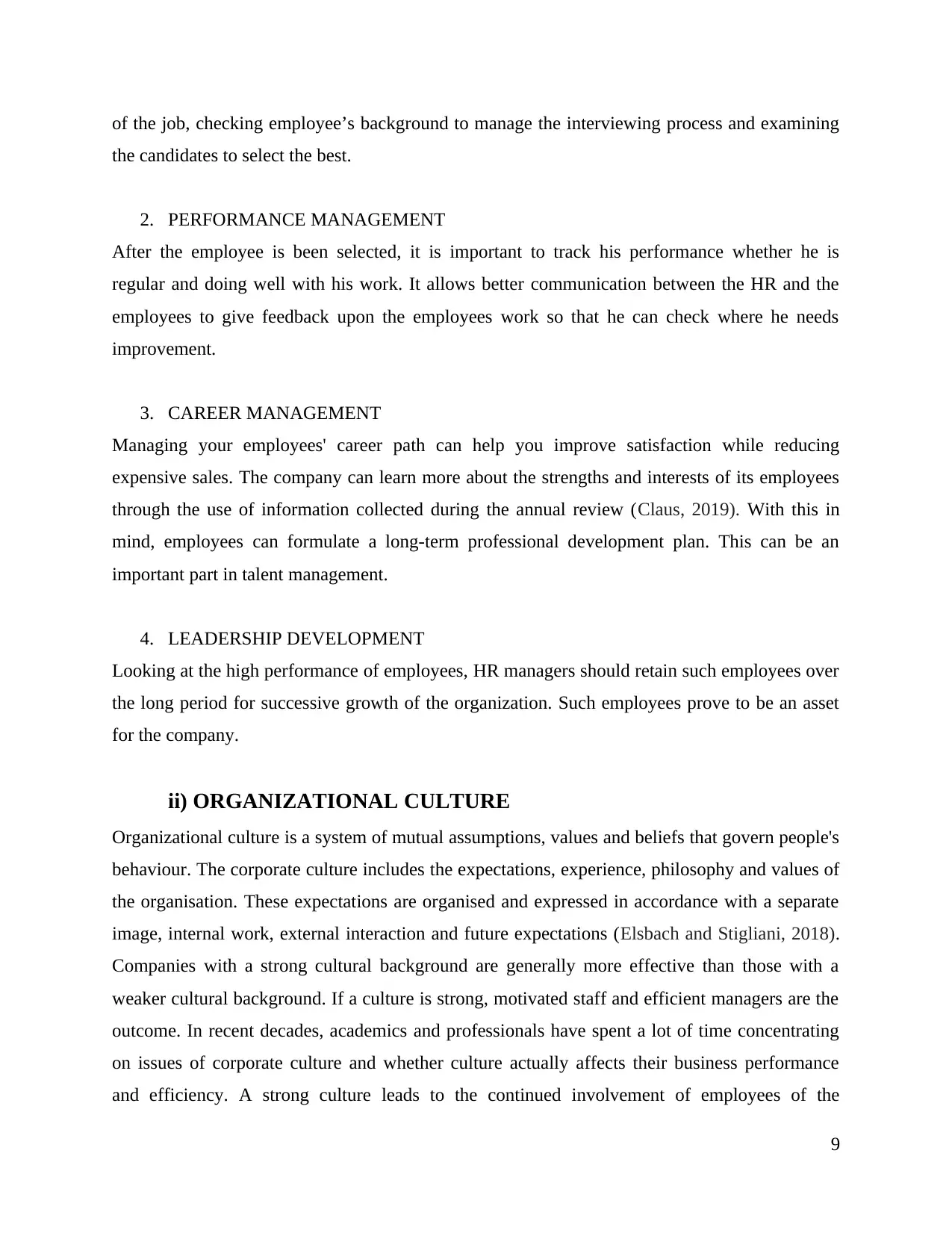
of the job, checking employee’s background to manage the interviewing process and examining
the candidates to select the best.
2. PERFORMANCE MANAGEMENT
After the employee is been selected, it is important to track his performance whether he is
regular and doing well with his work. It allows better communication between the HR and the
employees to give feedback upon the employees work so that he can check where he needs
improvement.
3. CAREER MANAGEMENT
Managing your employees' career path can help you improve satisfaction while reducing
expensive sales. The company can learn more about the strengths and interests of its employees
through the use of information collected during the annual review (Claus, 2019). With this in
mind, employees can formulate a long-term professional development plan. This can be an
important part in talent management.
4. LEADERSHIP DEVELOPMENT
Looking at the high performance of employees, HR managers should retain such employees over
the long period for successive growth of the organization. Such employees prove to be an asset
for the company.
ii) ORGANIZATIONAL CULTURE
Organizational culture is a system of mutual assumptions, values and beliefs that govern people's
behaviour. The corporate culture includes the expectations, experience, philosophy and values of
the organisation. These expectations are organised and expressed in accordance with a separate
image, internal work, external interaction and future expectations (Elsbach and Stigliani, 2018).
Companies with a strong cultural background are generally more effective than those with a
weaker cultural background. If a culture is strong, motivated staff and efficient managers are the
outcome. In recent decades, academics and professionals have spent a lot of time concentrating
on issues of corporate culture and whether culture actually affects their business performance
and efficiency. A strong culture leads to the continued involvement of employees of the
9
the candidates to select the best.
2. PERFORMANCE MANAGEMENT
After the employee is been selected, it is important to track his performance whether he is
regular and doing well with his work. It allows better communication between the HR and the
employees to give feedback upon the employees work so that he can check where he needs
improvement.
3. CAREER MANAGEMENT
Managing your employees' career path can help you improve satisfaction while reducing
expensive sales. The company can learn more about the strengths and interests of its employees
through the use of information collected during the annual review (Claus, 2019). With this in
mind, employees can formulate a long-term professional development plan. This can be an
important part in talent management.
4. LEADERSHIP DEVELOPMENT
Looking at the high performance of employees, HR managers should retain such employees over
the long period for successive growth of the organization. Such employees prove to be an asset
for the company.
ii) ORGANIZATIONAL CULTURE
Organizational culture is a system of mutual assumptions, values and beliefs that govern people's
behaviour. The corporate culture includes the expectations, experience, philosophy and values of
the organisation. These expectations are organised and expressed in accordance with a separate
image, internal work, external interaction and future expectations (Elsbach and Stigliani, 2018).
Companies with a strong cultural background are generally more effective than those with a
weaker cultural background. If a culture is strong, motivated staff and efficient managers are the
outcome. In recent decades, academics and professionals have spent a lot of time concentrating
on issues of corporate culture and whether culture actually affects their business performance
and efficiency. A strong culture leads to the continued involvement of employees of the
9
⊘ This is a preview!⊘
Do you want full access?
Subscribe today to unlock all pages.

Trusted by 1+ million students worldwide
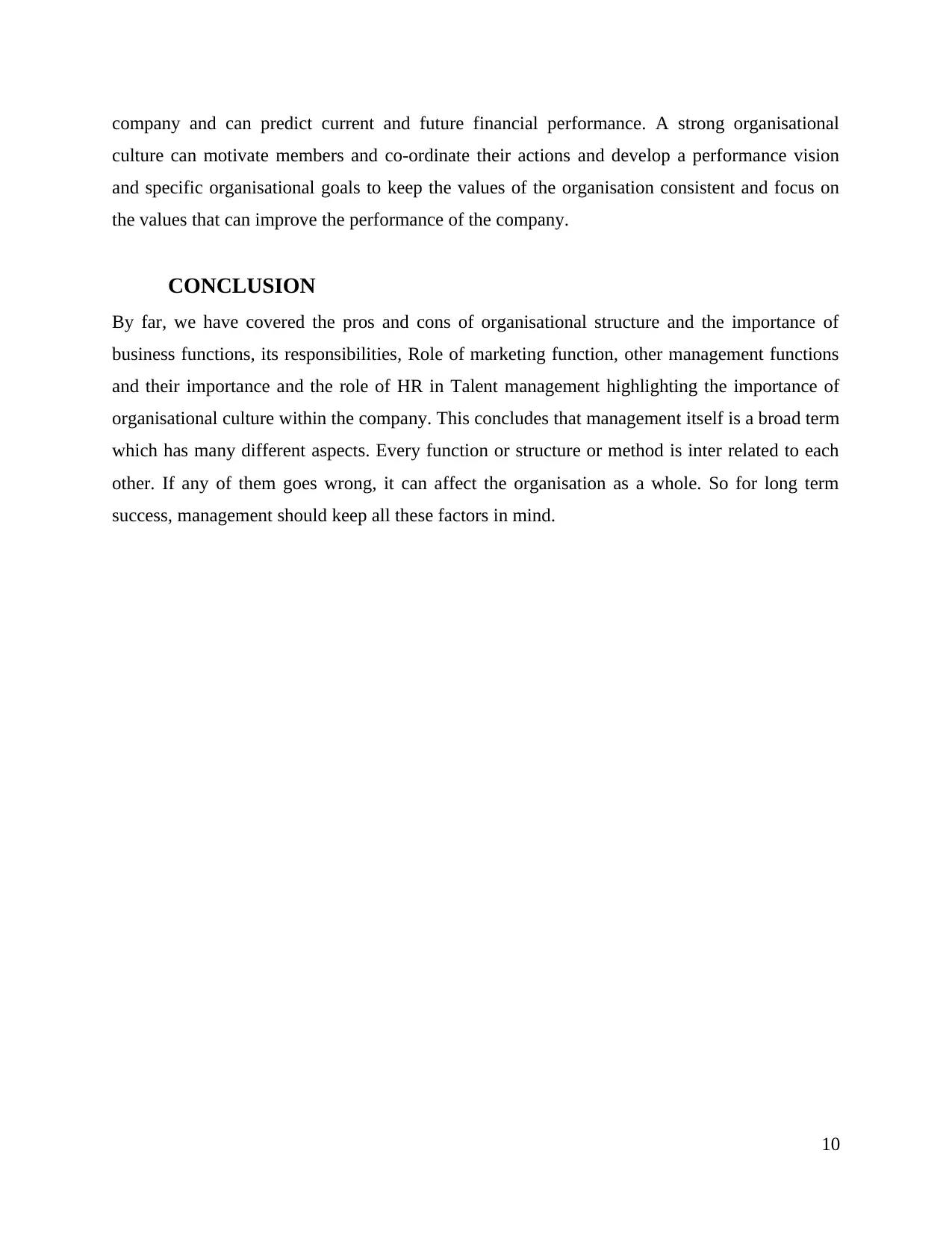
company and can predict current and future financial performance. A strong organisational
culture can motivate members and co-ordinate their actions and develop a performance vision
and specific organisational goals to keep the values of the organisation consistent and focus on
the values that can improve the performance of the company.
CONCLUSION
By far, we have covered the pros and cons of organisational structure and the importance of
business functions, its responsibilities, Role of marketing function, other management functions
and their importance and the role of HR in Talent management highlighting the importance of
organisational culture within the company. This concludes that management itself is a broad term
which has many different aspects. Every function or structure or method is inter related to each
other. If any of them goes wrong, it can affect the organisation as a whole. So for long term
success, management should keep all these factors in mind.
10
culture can motivate members and co-ordinate their actions and develop a performance vision
and specific organisational goals to keep the values of the organisation consistent and focus on
the values that can improve the performance of the company.
CONCLUSION
By far, we have covered the pros and cons of organisational structure and the importance of
business functions, its responsibilities, Role of marketing function, other management functions
and their importance and the role of HR in Talent management highlighting the importance of
organisational culture within the company. This concludes that management itself is a broad term
which has many different aspects. Every function or structure or method is inter related to each
other. If any of them goes wrong, it can affect the organisation as a whole. So for long term
success, management should keep all these factors in mind.
10
Paraphrase This Document
Need a fresh take? Get an instant paraphrase of this document with our AI Paraphraser
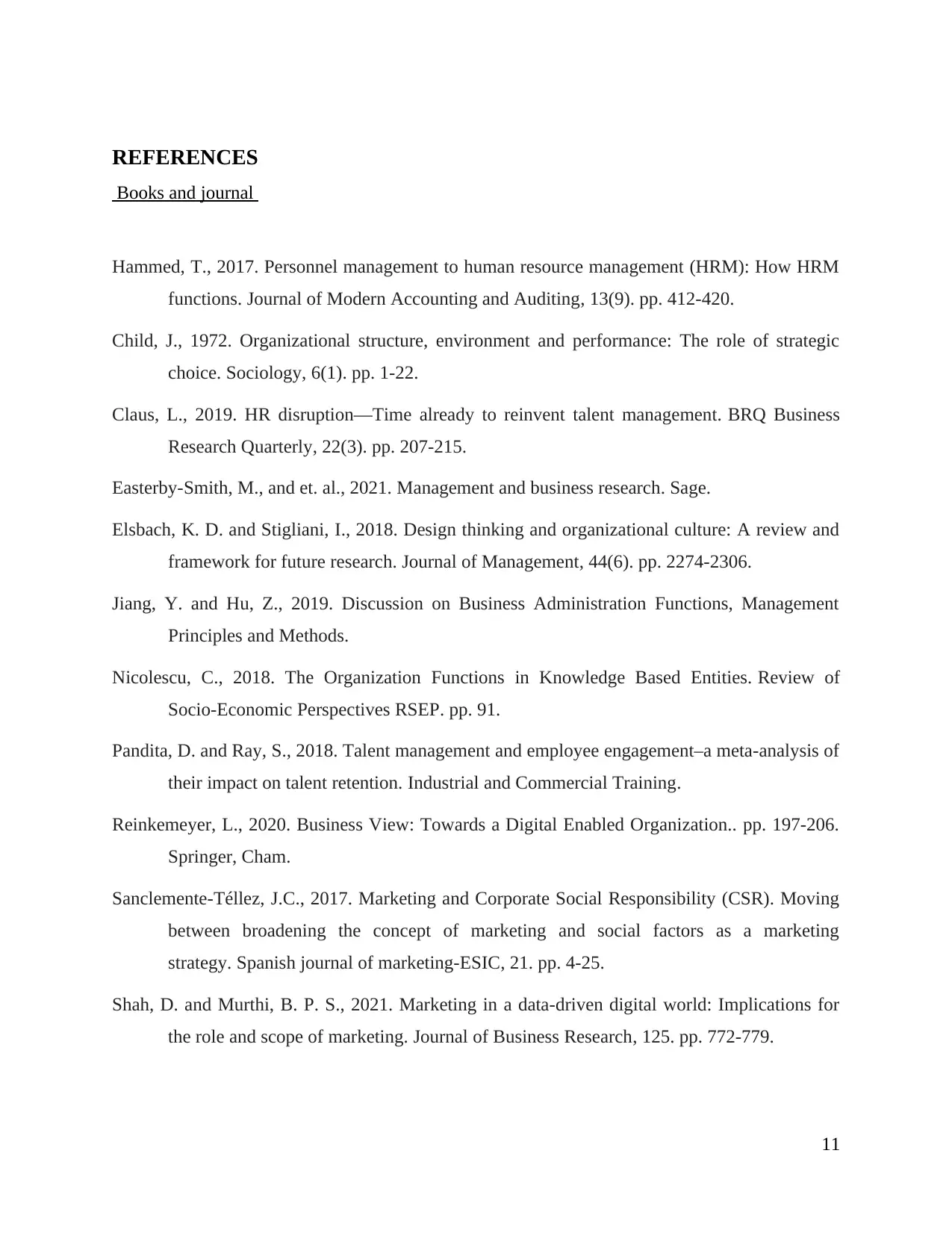
REFERENCES
Books and journal
Hammed, T., 2017. Personnel management to human resource management (HRM): How HRM
functions. Journal of Modern Accounting and Auditing, 13(9). pp. 412-420.
Child, J., 1972. Organizational structure, environment and performance: The role of strategic
choice. Sociology, 6(1). pp. 1-22.
Claus, L., 2019. HR disruption—Time already to reinvent talent management. BRQ Business
Research Quarterly, 22(3). pp. 207-215.
Easterby-Smith, M., and et. al., 2021. Management and business research. Sage.
Elsbach, K. D. and Stigliani, I., 2018. Design thinking and organizational culture: A review and
framework for future research. Journal of Management, 44(6). pp. 2274-2306.
Jiang, Y. and Hu, Z., 2019. Discussion on Business Administration Functions, Management
Principles and Methods.
Nicolescu, C., 2018. The Organization Functions in Knowledge Based Entities. Review of
Socio-Economic Perspectives RSEP. pp. 91.
Pandita, D. and Ray, S., 2018. Talent management and employee engagement–a meta-analysis of
their impact on talent retention. Industrial and Commercial Training.
Reinkemeyer, L., 2020. Business View: Towards a Digital Enabled Organization.. pp. 197-206.
Springer, Cham.
Sanclemente-Téllez, J.C., 2017. Marketing and Corporate Social Responsibility (CSR). Moving
between broadening the concept of marketing and social factors as a marketing
strategy. Spanish journal of marketing-ESIC, 21. pp. 4-25.
Shah, D. and Murthi, B. P. S., 2021. Marketing in a data-driven digital world: Implications for
the role and scope of marketing. Journal of Business Research, 125. pp. 772-779.
11
Books and journal
Hammed, T., 2017. Personnel management to human resource management (HRM): How HRM
functions. Journal of Modern Accounting and Auditing, 13(9). pp. 412-420.
Child, J., 1972. Organizational structure, environment and performance: The role of strategic
choice. Sociology, 6(1). pp. 1-22.
Claus, L., 2019. HR disruption—Time already to reinvent talent management. BRQ Business
Research Quarterly, 22(3). pp. 207-215.
Easterby-Smith, M., and et. al., 2021. Management and business research. Sage.
Elsbach, K. D. and Stigliani, I., 2018. Design thinking and organizational culture: A review and
framework for future research. Journal of Management, 44(6). pp. 2274-2306.
Jiang, Y. and Hu, Z., 2019. Discussion on Business Administration Functions, Management
Principles and Methods.
Nicolescu, C., 2018. The Organization Functions in Knowledge Based Entities. Review of
Socio-Economic Perspectives RSEP. pp. 91.
Pandita, D. and Ray, S., 2018. Talent management and employee engagement–a meta-analysis of
their impact on talent retention. Industrial and Commercial Training.
Reinkemeyer, L., 2020. Business View: Towards a Digital Enabled Organization.. pp. 197-206.
Springer, Cham.
Sanclemente-Téllez, J.C., 2017. Marketing and Corporate Social Responsibility (CSR). Moving
between broadening the concept of marketing and social factors as a marketing
strategy. Spanish journal of marketing-ESIC, 21. pp. 4-25.
Shah, D. and Murthi, B. P. S., 2021. Marketing in a data-driven digital world: Implications for
the role and scope of marketing. Journal of Business Research, 125. pp. 772-779.
11
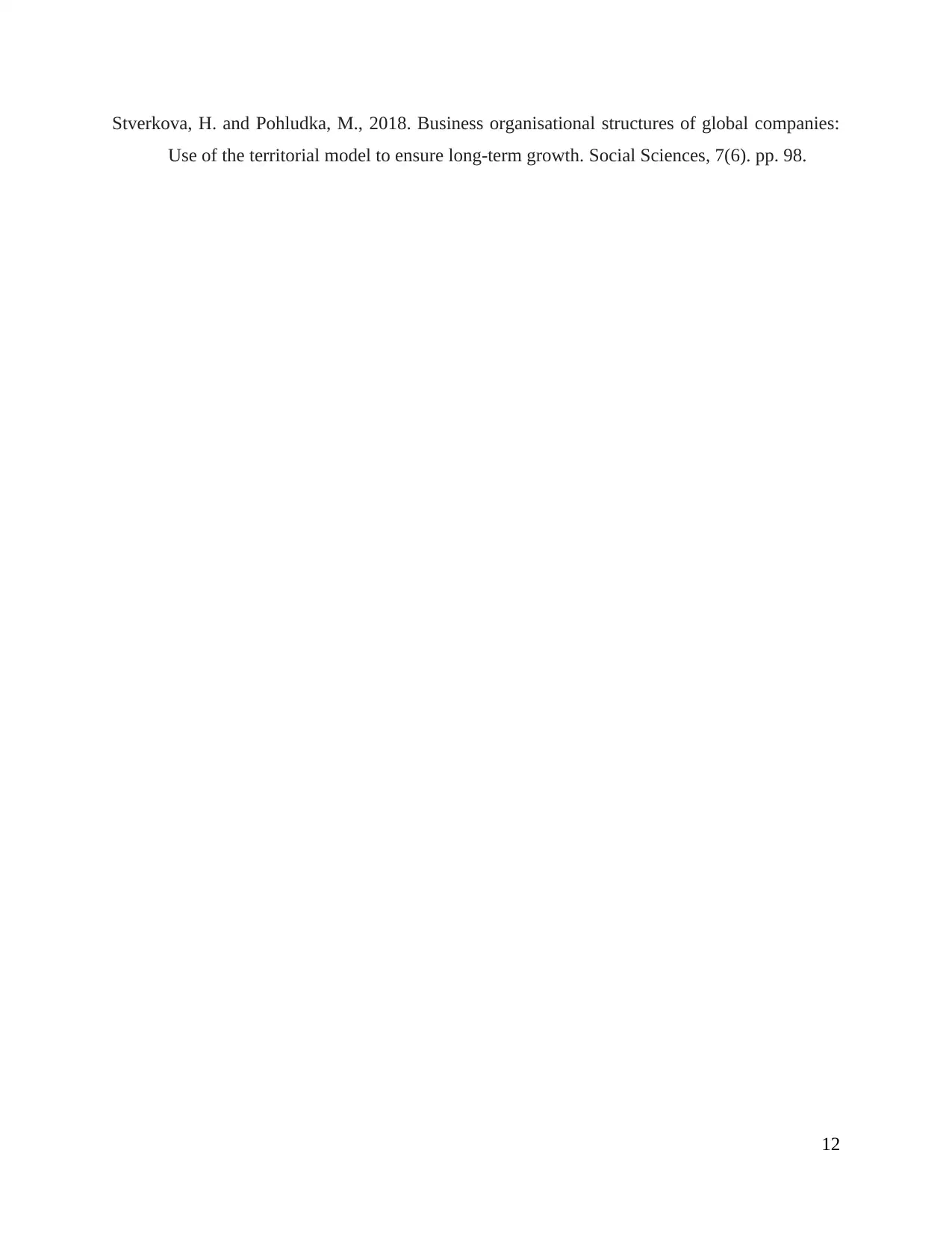
Stverkova, H. and Pohludka, M., 2018. Business organisational structures of global companies:
Use of the territorial model to ensure long-term growth. Social Sciences, 7(6). pp. 98.
12
Use of the territorial model to ensure long-term growth. Social Sciences, 7(6). pp. 98.
12
⊘ This is a preview!⊘
Do you want full access?
Subscribe today to unlock all pages.

Trusted by 1+ million students worldwide
1 out of 12
Related Documents
Your All-in-One AI-Powered Toolkit for Academic Success.
+13062052269
info@desklib.com
Available 24*7 on WhatsApp / Email
![[object Object]](/_next/static/media/star-bottom.7253800d.svg)
Unlock your academic potential
Copyright © 2020–2025 A2Z Services. All Rights Reserved. Developed and managed by ZUCOL.
